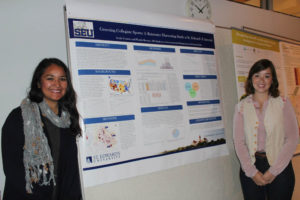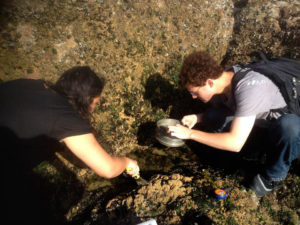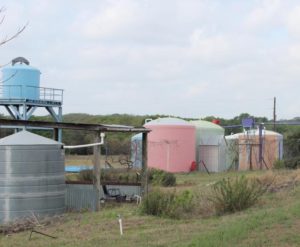Raindrops, so many raindrops. . . and when they were harvested from roofs in Texas, environmental scientist Phoebe Romero calculated how many barrels of rainwater they would produce and how many fields could be irrigated by those barrels. In the Texas hill country, rainwater harvesting is a key to sustainability. Metal roofs have a higher run-off than asphalt roofs and produce more usable rainwater. Romero used both math and mapping to predict where cisterns (rain barrels) were best placed for collection.
That’s only one of Phoebe Romero’s projects. As an environmental management and sustainability scientist, Romero wants to raise awareness of the “human side” of sustainability issues. She shows people that improving the environment (cleaning the soil, water, and air) can improve their health and give them access to better food and places to live. Her work as a Program Consultant at CLEAResult gives her the opportunity to help schools, universities, and government organizations become more energy efficient. Thanks in part to Romero’s help, people use less fossil fuel, reduce pollution, and save money.

The problems of sustainability are “very personal with the types of communities” Romero works with. She speaks to community groups, teaching them about the importance of projects like the one she did to plan rainwater collection. Historically, low-income communities have had to deal with power plants and other major sources of pollution in their neighborhoods, yet during a recent presentation in Austin, someone told Romero that environmentalism is “for people who are rich; not for me.” Helping people understand that cleaner air, soil, and water will help them and their families live better lives is one of Romero’s goals.
Romero recently finished an Environmental Defense Fund (EDF) Climate Corps fellowship at Huston-Tillotson University, a historically black university founded in the 19th century in Austin, TX. She told Math4Science about a group at Huston-Tillotson called Green is the New Black, whose Dumpster Project turned a garbage dumpster into a home people could live in. (What lessons do you think the students of Green is the New Black want us to learn from the Dumpster Project?)

Earlier, Romero helped the Texas Commission on Environmental Quality, as part of the Mickey Leland Environmental Internship program. “The internship was with the Monitoring Division, where I helped maintain their air quality monitoring stations throughout Texas, and created a database for equipment inventory.” One common problem in Texas and throughout the world is ozone, which pollutes the air. There is good ozone high in Earth’s atmosphere, protecting us from the Sun’s ultraviolet rays. But at ground level, “bad ozone,” made from reactions between man-made chemicals and nitrogen oxides, can make it harder for people to breathe and for certain other forms of life to survive. Having determined whether ozone levels were “good, warning, or critical,” Romero and her colleagues colored in maps to show the levels in areas of Texas.
While working on the ozone project, Romero designed a new database for her supervisor and enjoyed working with GIS (geographic information system) to map and analyze information they collected. “We could color in ‘warning,” she says, “to map out a specific [level of] particulate-matter ozone.”
How can a university help the environment without spending too much money? Budget is a concern of every project Romero works on, from the rainwater collection system to a proposal she made for a gymnasium. What would it cost to replace the gym’s natural gas water heater with a solar thermal system? How much energy (measured in British thermal units — BTUs — and kilowatt hours) would this save? By what percent would the energy the gym used now be reduced? Romero used math “to sell the environmental case” and to show decision-makers at Huston-Telletin how long it would take for the new system to start saving them money.
Phoebe was born in Mexico, in a town surrounded by mountains. But natural landscapes were not always part of Romero’s life. “I was born in Saltillo, Coahuila, but moved to a border city called Matamoros, Tamaulipas when I was just two.” When she was eight years old, Phoebe and her mother emigrated from Mexico to Texas’s Rio Grande Valley. In both Mexico and Texas, they lived in cities, and it was only during family visits to Saltillo that she was exposed to green space. She feels that those visits to Saltillo explain her affinity to mountains and natural landscapes. “To me they are a representation of my origins,” she says.
Romero’s mother is an industrial engineer who encouraged her daughter to study math and science. In high school, Phoebe loved math and particularly enjoyed calculus, but she noticed that there were relatively few people of Latino origins involved in math, people “that represent my background.” In college, she originally wanted to study biomedical engineering but switched to a focus on international politics, Latin American history, and human rights.

So Romero didn’t begin her career using math for science. After graduating from Brown University, where she majored in political science and Latin American studies, she joined Texas Teaching Fellows and taught bi-lingual second and fourth grades in Austin. As a teacher, she used math to calculate grades, mostly derived from the many tests her students took throughout the year. Thanks to all of those exams, Romero sometimes didn’t feel she or her students were having a rich educational experience–but when she taught them about renewable energy and environmental issues, they became truly excited and engaged.
That excitement inspired her. Leaving classroom teaching, Romero decided to build on her interests in both math and ecology and find a program that meshed with and enhanced those interests. “I now realize that science, policy and social justice all intersect,” she says. Romero did a degree in environmental management and sustainability at St. Edwards University in Austin, where she did the rainwater project.
And she still wants to work with kids, particularly in migrant and poor communities. “A lot of them think” that if you’re an ecologist, “you’ll be wearing khakis, staring at animals. But you can be in an office and you can also travel a lot.” As her own school and work history, which took her from Latin American studies and political science to teaching to designing better heating and water systems for universities, demonstrates, “it’s important for students to keep in mind that there’s a diversity of jobs in the environmental field and their interests can be met by all of these different positions.”


